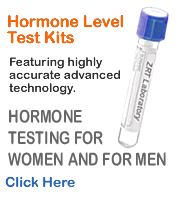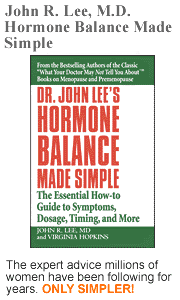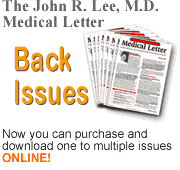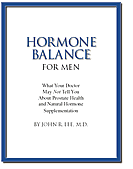|
|
||||
|
For suggestions on how to find a doctor in your area, please go to:  |
||||
|
Testosterone Booster, Male Menopause (Andropause) and Hormones |
||||
TESTOSTERONE, MALE MENOPAUSE AND HORMONE BALANCE IN MEN by John R. Lee, M.D. Commentary on an Article by Jerome Groopman, published in the New Yorker magazine, July 29, 2002 Mr. Groopman discusses the commercialization of “andropause,” a moniker that implies a fall in androgen hormones similar to the menopausal fall of estrogen in women. The commercialization comes via Unimed, a division of Solvay, a Belgian conglomerate that includes pharmaceuticals. Unimed hopes to broaden the concept of andropause to include men with symptoms of fatigue, low sex drive, depressed mood, or poor erections. Their product, AndroGel, is a 1% transdermal gel, i.e., containing 10 milligrams (mg) of testosterone per gram of gel. Their recommended dose, as listed by their three page ad in this week's TIME magazine, is 5 grams of gel (50 mg of testosterone). The author points out that FDA approval of AndroGel was given for treating rather rare disorders such as Klinefelter s syndrome (a rare genetic disorder causing underdeveloped testes), or testes damaged by viral inflammation or trauma, and pituitary disorders that lead to loss of testicular function, and not for “andropause.” Once a drug is approved for sale, however, physicians can legally prescribe it for any clinical condition he thinks might benefit from it. Mr. Groopman's article describes the dichotomy between physicians who find it useful (and remunerative) for practically every man entering their offices, and medical scientists who are still uneasy about the definition of andropause and question the use of supplemental testosterone. Points of difference include the questionable value of blood tests and the wide variability of testosterone levels in men without any sign of andropause symptoms, the subjective nature of so-called benefits, as well as testosterone's potential risk of heart attacks and prostate cancer, and the claims that testosterone prevents aging. Unfortunately, Mr. Groopman does not seem to understand that risk of hormone side effects is largely a matter of dosage. In his conclusion, the author regards the present surge of testosterone replacement therapy by approximately a quarter of a million American men to be a vast, uncontrolled experiment, whose consequences remain uncertain. He feels that what is needed is large scale study involving “many thousands of men” over a period of many years, such as was done for women in the Women s Health Initiative (WHI) study of conventional HRT. Medicine s Lack of Understanding about Male Hormone Balance I find the article, written in the cool, cosmopolitan style so adored by the New Yorker magazine, to be glib and mistaken in its underlying hypotheses. Yes, there is a parallel with the problems uncovered by the recently stopped WHI study. The major problem is conventional medicine's lack of understanding of the realities of hormone balancing. Any single hormone does not work in isolation – it works something like a member of a large orchestra with many different players. The question of testosterone's role can not be determined, in most cases, by knowing merely its serum concentration. What is the right level for one person may not be right for another person. Absolute levels are deceptive. Far more relevant is the ratio between testosterone and estradiol concentrations. Testosterone is an antagonist of estradiol; it acts to oppose estradiol's actions. Thus, a given estradiol level will lead to breast growth in a man with low testosterone, and not in a man with higher testosterone levels. Testosterone and Estrogen in Men It is well known that the estradiol level in 55-year old men, for example, is usually a bit higher than that of a 55-year old woman. The man, however, does not develop breasts because he has a higher testosterone level than women do. As men age, their estradiol levels gradually rise, whereas their progesterone and testosterone levels gradually fall. The hormone balance changes. These gradual changes lead to reduction in testosterone benefits and eventually to estrogen dominance. That is, his estradiol effects emerge since his testosterone level is not sufficient to block or balance them. Estrogen dominance stimulates breast cell growth and endometrial cell proliferation in women. In men, estrogen dominance stimulates breast cell growth and prostate hypertrophy. Estrogen dominance is responsible for the majority of breast cancers and is the only known cause of endometrial cancer in women. Since the male prostate is the embryonic equivalent of the uterus, is should not be surprising that estrogen dominance is also a major cause of prostate cancer. Testosterone Supplementation in Men Testosterone supplementation is the obvious treatment for men with testosterone deficiency relative to their estradiol levels. If the estradiol, progesterone, and testosterone balance that prevails in younger men (when they do not get prostate cancer) is a healthy one, why not restore the hormone levels in older men to that same healthy balance? To achieve this desired goal of a healthy balance between these major sex hormones, one must learn how to accurately measure their levels. All steroid hormones are fat-soluble. When they circulate through the liver they get wrapped up, so-to-speak, by a protein coating, a process known as protein binding. When protein-bound, the hormones are water soluble but less bioavailable. Being water-soluble, the protein-bound hormones pass through the kidneys and are excreted in the urine. The non-protein-bound hormone (referred to as “free” hormone) on the other hand, is the bioavailable form of the hormone. It is fat-soluble and is carried in blood by red blood cells rather than in the serum, that is the watery, non-cellular portion of the blood. When the blood circulates through the tissue of the salivary glands, the “free” hormone, whether in red blood cells or in the serum, filters through into the saliva, whereas the protein-bound form does not. If one wished to know the concentration of “free” bioavailable hormone in the blood, it is obvious that saliva hormone levels are more accurate and more relevant than serum hormone levels. Serum vs. Saliva Holds True for Men Too For reasons that escape rational thinking, conventional medicine persists in using serum tests rather than saliva tests. The results have been disastrous. When using hormone creams or gels, the hormone is absorbed through the skin and into the blood without first passing through the liver. Thus, they are essentially all absorbed in the “free” form. When given orally, they pass first through the liver and 90% of them become protein-bound. For this reason, transdermal dosing is at least 10 times more efficient than oral dosing. If one uses serum testing to measure the blood levels achieved by transdermal dosing, the test will fail to measure all the hormone carried by red blood cells. As a consequence, physicians are apt to greatly over-dose their patients. When using saliva testing, it is found that the transdermal dose of testosterone when treating someone with testosterone deficiency is only 0.25-0.5 mg in women, and 1-2 mg in men. As the New Yorker article indicated, the transdermal doses of testosterone ranged from 5 mg to 100 mg a day. The same is observed in estrogen replacement therapy – the doses are generally all greatly excessive. The same hormone that brought good health without side effects when in normal endogenous levels will bring on very bad side effects when given in grossly excessive doses. The problem is not the hormone, per se, the problem is the dosing. Some physicians have attempted to measure “free” hormones in serum. Regardless of how well this is done, such tests fail to measure the “free” hormone being carried by red blood cells. Use Only Bio-identical, Natural Hormones The final correction that must be made is equally obvious – when treating someone with a hormone deficiency, use only bio-identical hormones. Altered, synthetic versions of our natural hormones will not do – they are foreign to the body, do not convey the same benefits as the real hormone, and all are fraught with undesirable side effects not conveyed by the real hormone. Our problems in using hormones can be solved by the four guidelines summarized below:
Failure to follow these three guidelines is the principal cause of the problems exposed by the Women s Health Initiatives. The makers of AndroGel use bio-identical testosterone but their dosing regulations are faulty and dangerous. Any good compounding pharmacist can make up a testosterone cream that will more easily supply the right dose of testosterone in men with estrogen dominance due to testosterone deficiency. For more information on this topic, please read Hormone Balance for Men a booklet by John R. Lee, M.D.
|
||||





